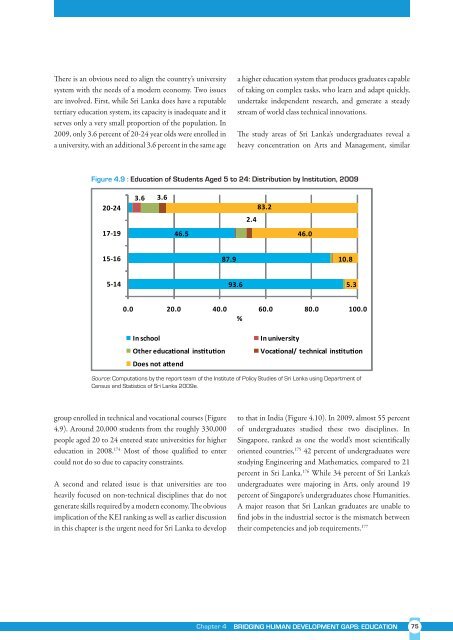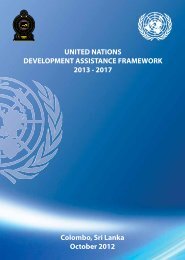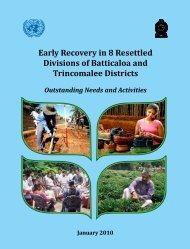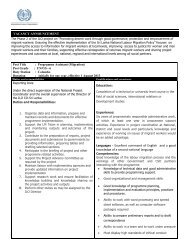Sri Lanka Human Development Report 2012.pdf
Sri Lanka Human Development Report 2012.pdf
Sri Lanka Human Development Report 2012.pdf
You also want an ePaper? Increase the reach of your titles
YUMPU automatically turns print PDFs into web optimized ePapers that Google loves.
There is an obvious need to align the country’s university<br />
system with the needs of a modern economy. Two issues<br />
are involved. First, while <strong>Sri</strong> <strong>Lanka</strong> does have a reputable<br />
tertiary education system, its capacity is inadequate and it<br />
serves only a very small proportion of the population. In<br />
2009, only 3.6 percent of 20-24 year olds were enrolled in<br />
a university, with an additional 3.6 percent in the same age<br />
a higher education system that produces graduates capable<br />
of taking on complex tasks, who learn and adapt quickly,<br />
undertake independent research, and generate a steady<br />
stream of world class technical innovations.<br />
The study areas of <strong>Sri</strong> <strong>Lanka</strong>’s undergraduates reveal a<br />
heavy concentration on Arts and Management, similar<br />
Figure 4.9 : Education of Students Aged 5 to 24: Distribution by Institution, 2009<br />
Source: Computations by the report team of the Institute of Policy Studies of <strong>Sri</strong> <strong>Lanka</strong> using Department of<br />
Census and Statistics of <strong>Sri</strong> <strong>Lanka</strong> 2009e.<br />
group enrolled in technical and vocational courses (Figure<br />
4.9). Around 20,000 students from the roughly 330,000<br />
people aged 20 to 24 entered state universities for higher<br />
education in 2008. 174 Most of those qualified to enter<br />
could not do so due to capacity constraints.<br />
A second and related issue is that universities are too<br />
heavily focused on non-technical disciplines that do not<br />
generate skills required by a modern economy. The obvious<br />
implication of the KEI ranking as well as earlier discussion<br />
in this chapter is the urgent need for <strong>Sri</strong> <strong>Lanka</strong> to develop<br />
to that in India (Figure 4.10). In 2009, almost 55 percent<br />
of undergraduates studied these two disciplines. In<br />
Singapore, ranked as one the world’s most scientifically<br />
oriented countries, 175 42 percent of undergraduates were<br />
studying Engineering and Mathematics, compared to 21<br />
percent in <strong>Sri</strong> <strong>Lanka</strong>. 176 While 34 percent of <strong>Sri</strong> <strong>Lanka</strong>’s<br />
undergraduates were majoring in Arts, only around 19<br />
percent of Singapore’s undergraduates chose <strong>Human</strong>ities.<br />
A major reason that <strong>Sri</strong> <strong>Lanka</strong>n graduates are unable to<br />
find jobs in the industrial sector is the mismatch between<br />
their competencies and job requirements. 177<br />
Chapter 4 Bridging <strong>Human</strong> <strong>Development</strong> Gaps: EDUCATION 75






